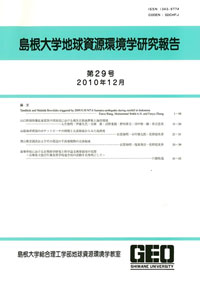島根大学総合理工学部地球資源環境学教室
ISSN:1343-9774

ダウンロード数 : ? 件
この文献の参照には次のURLをご利用ください : https://ir.lib.shimane-u.ac.jp/6085
島根大学地球資源環境学研究報告 20
2001-12-28 発行
PaleohydrologicaI Reconstruction of the Siwalik Group,Surai Khola area along the Kalakati and Bhalubang Sections,West Nepal
Ulak, Prakash Das
中山 勝博
ファイル
内容記述(抄録等)
Paleohydrological reconstructions(channel bed slopes,flow velocity,and bankfull discharge)have been made of the Bankas Formation and the Jungli Khola and Shivgarhi members of the Chor Khola Formation of the Siwalik Group,west Nepal.The succession examined is a stratigraphic thickness of about 1500 m exposed between Kalakati and Bhalubang section.Estimates of channel bed slope,flow velocity,and bankfull discharge have been made based on grain size and bedload thickness.Grain size was determined by conventional petrologic thin section point-counting or by settling tube methodology.Bedload thickness was measured in autogenic fining-upward fluvial successions.During the middle Miocene to lower Pliocene epochs,the paleoslope gradient ranged from 7.06×10^<−4> to 8.28×10^<−4> m/m in the Bankas Formation,from 5.84×10^<−4> to 7.71×10^<−4> m/m in the Jungli Khola Member(Chor Khola Formation),and from 6.32×10^<−4> to 8.71×10^<−4> m/m in the Shivgarhi Member(Chor Khola Formation).Paleovelocities in these three units are estimated to be 0.46 to 0.56 m/s,0.50 to 0.61 m/s and 0.53 to 0.66 m/s,respectively.Paleodischarge estimates are 0.44×10^0 to 1.43×10^3,1.12×10^2 to 3.06×10^3,and 1.45×10^2 to 4.89×10^3 m^3/s,respectively.Progressive increase in these paleohydrological parameters suggests that uplift of the Himalaya took place during the Neogene.
Other Article
